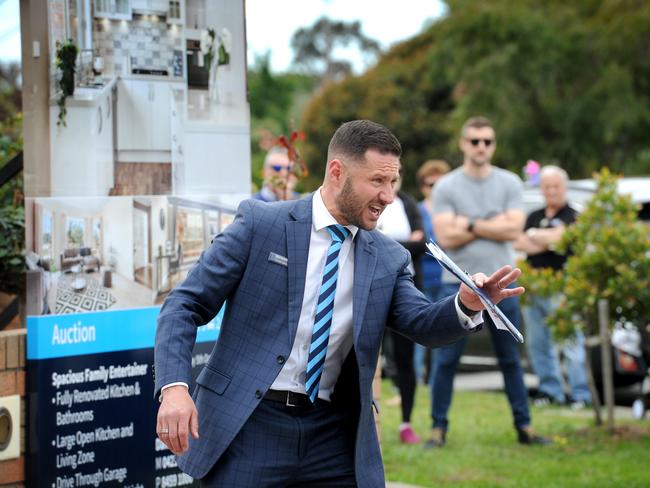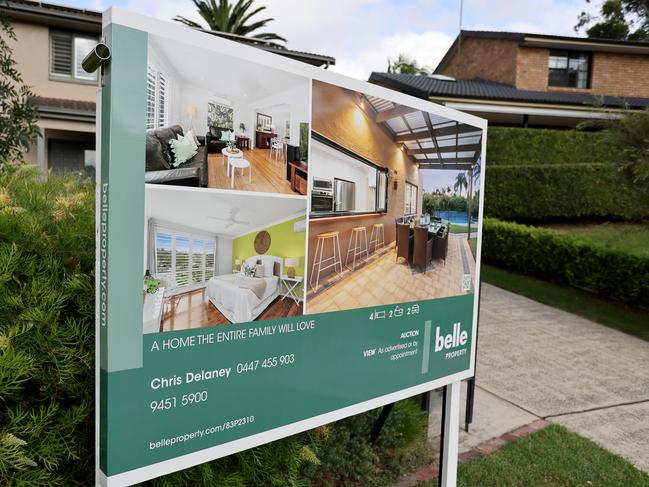Interest rates, real estate: Investors hit the brakes as sentiment suffers
After record levels of borrowing earlier this year, investors are now exiting the real estate market in droves, for a number of reasons.
Property
Don't miss out on the headlines from Property. Followed categories will be added to My News.
There has been a nascent shift in property investor sentiment, which may have seen off the peak in the investor market. It emerged in this week’s investor housing update which saw a 4.8 per cent fall in loan commitments to $11.1 billion, according to the Australian Bureau of Statistics.
The reversal came after nine consecutive months of growth since June 2021.
There had been a peak in March this year to $11.64 billion, which nicely outdid the $10 billion prior borrowing peak in 2015.
Despite the decrease, the value of lending in April sat 113 per cent higher than pre-pandemic February 2020. The ABS head of finance and wealth Katherine Keenan pointed out the Easter break would have softened borrower demand and limited loan processing during April.
The April drop in investor loan commitments saw Queensland with a 17 per cent decline, while New South Wales saw lending fall by 8 per cent, and Victoria was down 5 per cent.
The declines suggest a market that’s beginning to cool, and for a number of reasons.
It’s an understandable reaction for some investors to wait out the evolving market and see how things play out over upcoming months.

For starters there’s the obvious pending impact of rising interest rates as investors wait and see just how high mortgage rates will go.
And remember investors have paid higher rates than owner occupiers even since the banking royal commission.
Investors will also be monitoring whether property prices match the predictions of weakening prices.
There has been a spate of headlines suggesting there’s an acute vacancy rate that certainly requires research by intending investors in whatever their preferred neighbourhood.
It has become obvious that not all landlords have been benefiting from the post-pandemic trends after rents fell back in the past two years across much of Sydney and Melbourne.
PropTrack recently calculated rents have been unchanged in Melbourne over the last year to the March quarter and just 2 per cent higher in Sydney, although rents have continued to fall for instance in Sydney’s Inner South West.
Meanwhile regional NSW landlords saw a 12.5 per cent rise in rents, with double-digit rises in regional Victoria too.
The pandemic growth in property prices has certainly pushed gross rental yields lower, another key factor which investors need to be across. They sit at 3.7 per cent across the capital cities and 4.8 per cent across the regions.
Gross rental yields are the lowest in Sydney at 3.2 per cent, then Melbourne at 3.5 per cent. Sydney landlords enjoyed 3.9 per cent yields in late 2019.
Of course the yield compression is not confined just to property.
Yields on most investment asset classes are at historically low levels in part to historically low interest rates along with high demand from investors champing at the bit to put their money somewhere other than bank deposits.
WHY WINTER WILL FURTHER COOL SYDNEY’S PROPERTY MARKET
The winter selling season is here, though potentially without the elevated sales activity experienced during the boomtime winter of 2021.
The normalisation of winter activity will be a response, in part, to the pent up desire by Australians to travel overseas this winter, along with other cooling property market factors. Of course international travel was just not possible in the past two winters during the Covid-19 pandemic, which saw stay-at-home estate agents continue to turn up to their offices to list and sell.
NSW estate agents secured around 66,000 sales in winter last year, according to NSW Officer of State Revenue data. It had been 44,000 in the first lockdown pandemic winter in 2020, up slightly from the 43,000 sales in the pre-pandemic winter of 2019.
Notwithstanding the limited flight capacity, standby for the exodus of estate agents who’ll resume taking their glamorous mid-year holiday break given the opening of international borders.

Of course the potential buyer and seller client pool will have their own travel plans too in many prestigious Sydney residential markets.
Data from the Department of Foreign Affairs and Trade (DFAT) shows rising numbers in international passenger departures. The March departures sat at 335,000, up from 176,000 in February.
Monthly pre-pandemic winter departures typically sat at around 1.7 million departures.
It will be wise for potential sellers to check whether their intended listing agent has scheduled an overseas break so they can decide whether the listing can proceed with the junior team who stay behind.
In the past estate agents regularly posted Instagram photos of their glamorous travel exploits, but this big-noting stopped as it tipped off their rival agents back home to their absence which they then used to their advantage in securing listings.
The winter weekend auction market is now underway, with 852 auctions across Sydney and 189 across regional NSW this weekend.
That is down from 1042 and 225 last weekend.
Proptrack calculates there will be a big dip around the Queen’s Birthday long weekend which will see 570 auction offerings across Sydney and 130 in the regions.
There will be a jump in the week after the long weekend with auctions in Sydney at 784 and 214 across the regions, according to PropTrack. Interestingly that’s 32 per cent down for Sydney and 13 per cent in the regions compared to the same time last June.
A decade or so ago saw serious auction hibernation, but winter auction volumes have doubled over the decade with the motivation to sell or buy a home not going away just because it’s a bit colder.
Any lower winter market listings in 2022 will potentially assist vendors achieve sales closer to their asking prices given the laws of supply and demand.
There are still many committed intending buyers who’ve missed out in autumn. These intending buyers come with approved finance so they will be keen to buy and lock in their home loan mortgage loans before too many further rate rises.
RED TAPE MAY STRANGLE LABOR’S NEW HOMES SCHEME
There’s likely to be a post-election lull in the housing policy wars, but hopefully debate will soon return to the national dialogue on the best ways to boost home affordability.
Rather than just being ideas proposed during the federal election campaign, home buyers can anticipate a new housing purchase option.
It is Labor’s shared equity housing policy, its Help to Buy scheme, which will first need to be passed by the recently elected federal parliament.
The scheme is set to help people earning up to $90,000 (and $120,000 for couples) to buy a property with the government contributing up to 30 per cent of the purchase price for existing properties and up to 40 per cent for new builds.

The scheme is set to be limited to 10,000 places each year, so I’m not sure it will have a demonstrable impact on the national market.
But it will be open to not only those who are buying their first home but additionally for those who currently don’t own. Hopefully a chance for the many who’ve lost their home in their midlife divorce.
The property purchases will be capped across the capital cities and in the regions. In Sydney the cap is $950,000; in Melbourne $850,000; in Brisbane $650,000. It’s $600,000 in Canberra. In Perth, Adelaide, Hobart and Darwin, that price limit was set at $550,000. Regional locations have reduced caps so it’s $600,000 in regional NSW.
The price caps will therefore see demand towards the middle to lower end of the market with estimates that one in three suburbs nationwide will meet the caps.
Eligible home buyers will need a minimum deposit of 2 per cent, which would mean that for a homebuyer in Sydney, buying at $950,000 with 40 per cent equity, will see their monthly mortgage repayments at $1600 cheaper than otherwise.
Homebuyers will have also avoided paying Lenders Mortgage Insurance of around $30,000.
The mechanics of the ownership will see the homebuyer being able to buy additional equity in the home, and if their income exceeds the annual income threshold for two consecutive years, they will be required to repay the Government’s financial contribution with a flexible exit time frame.
There will accordingly be significant red tape.
The government also proposed a further 10,000 low deposit first home buyers a year in regional Australia, allowing them to save on paying mortgage insurance with the government guaranteeing up to 15 per cent of the purchase price. It’s a similar scheme to the successful Morrison government initiatives.

An Albanese Labor government will revamp the National Housing Finance and Investment Corporation, renaming it Housing Australia.
It will be the home of its intended National Housing Supply and Affordability Council, which will set targets for land supply in consultation with state and territory governments.
To pay the estimated $329m for its housing schemes over its first four years, Labor will double foreign investment screening fees and financial penalties.





